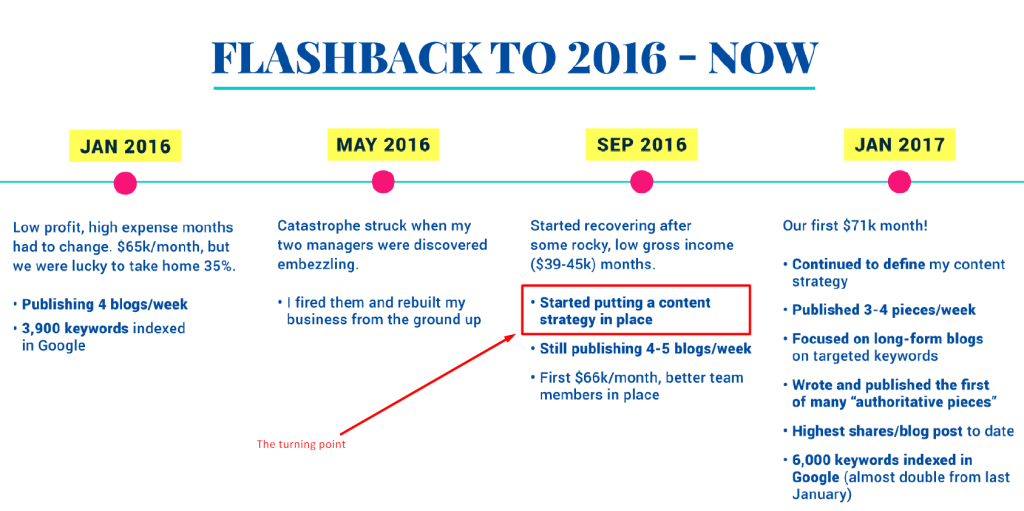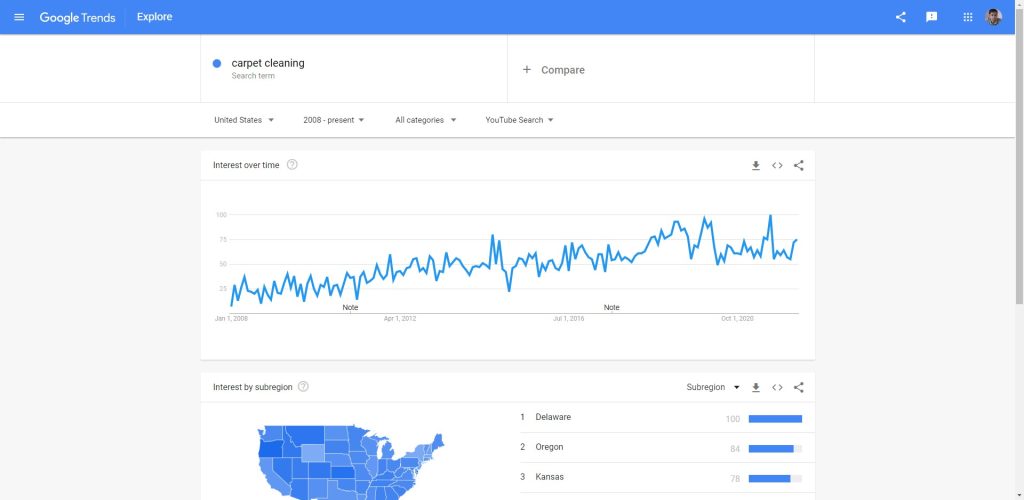How to Generate Real Business Benefits with Blogging
Admit it, you’re not blogging because you love putting words on a digital screen. You want recognition, fame or money or all three.
The goal with this post is to share the real benefits of business blogging with you and show you how it can generate the results you’re looking for.
- Increase Traffic to Your Site
Blogging is one of the best ways to increase the traffic to your site. Let’s hear it from ExpressWriters who have been blogging since the year 2012. They’ve published over 1188 different blog articles.
That’s around 150 to 160 posts a year and 14 to 15 posts a month.
As the numberof posts went up and they started posting high-quality
The blog got a new direction when they put the pedal on publishing high-quality content. They chose to publish 1 post per week and this strategy helped them get more traffic.
The sheer amount of content, and the consistency with which they publish new content today generate over 90000 visitors to their site every month.
Look at the image below to have a peek at the yearly revenue numbers, all thanks to blogging.

In 2016 they averaged $39000 to $45000 a month in revenue. That went up to $71000 in 2017 and then to $120000 in January.
When you start posting content frequently to your site, the effort that you put in, helps increase the blog’s value. As a direct result of your efforts, you can improve your site’s traffic and its value.
In general, higher traffic to your site leads to a higher number of leads be it B2C businesses or B2B businesses.
Even if you run a simple blog that sells ads, increased traffic is good news.
When you blog frequently, businesses small and big tend to see better results as a result of these efforts.
With frequent blogging you get more leads, higher rates of submissions to contact forms and and increased number of client inquiries.
Higher site traffic is great for business—especially for those businesses who leads arrived at your content when searching for solutions to their own problems.
To help your audience, the content you create should be tangible. It should have a direct benefit to the audience, say solve their pain points.
- Delete Content that is No longer useful and Increase Traffic
For Ahrefs the turning point with their content strategy came when they deleted a lot of their old content. Within three months, the traffic went up by 89%.
They had around 500 odd articles on the Ahrefs blog. Of that, they deleted around 266 articles which is about 49% of their total posts.
They chose which posts to delete based on a content and competitor audit they did.
Most blog owners never think about deleting old content. The blog posts you write today, continue to churn out value over the years. But the realization that almost half of the content they had posted got them zero visitors shook things up for Ahrefs.
Zero visits and zero engagement may mean the blog as a whole is on a downward spiral and could indicate that the blog isn’t as good for readers as it used to be.
After a content audit, they deleted 266 articles, adding to 179,000 words in total. For the deleted posts that had a backlink they did a redirect to another post. That let them preserve the link juice.
Along with deleting old content, came a content revamp strategy. They started posting less but made sure that the content they posted was really good.
They did keyword research to identify long-tail keyword groups. Next, they ran a competitor analysis report.
Immediately after deleting old content their search engine traffic increased. By how much? The traffic increased by nearly 90%.

This is a big improvement considering the bulk of work was about deleting old content.
In addition to deleting old consider value-adding existing content with tables, charts and graphs.
- New Content Helps you Get New Customers
Leads, and new customers are the lifeblood of any business. For how long can anyone continue to rely on old customers coming back?
It doesn’t matter what niche you’re in—be it a footwear brand, a dropshipping lifestyle site, a SaaS tool, blogging can help. And the more you blog, the more value you’re creating for potential clients.
This attention that you get from people translates to newer customers.
For instance, let’s look at the example of the Vinebox blog.
Vinebox with its content has positioned itself as a brand that people can trust. They have established themselves as industry leaders with their blog on wines. Customers when they finally pull the trigger on a bottle of wine are going to choose Vinebox as they’re the authority in the space.
Vinebox is also positioning itself as a brand that you can trust. By showing that they are the industry leaders on wine and that they really know what they are talking about, customers will trust Vinebox more when looking for the perfect wine. Vinebox is using their eCommerce blog to become recognized as an authority when it comes to all things wine.

The site above frequently update their blogs with both educational and inspiring content. That serves both new and old readers.
Today almost everyone would spend their time on search engines researching their purchases.
The more the cost associated with it, the more the time spent researching.
Engaging blog content on the subject can sway people’s opinions while also forming strong emotional ties. This can influence purchases.
When creating a blog strategy, try to spend a little bit of time out of your day to create an outline of ideas.
Here are a few more examples of what I’m talking about:
- A company in the carpet cleaning niche can post videos and engaging content on different carpets and different use-cases of their cleaning products. Educate potential customers.
- I noticed some carpet cleaning videos. They’re incredibly satisfying and have millions of views. Who would have guessed that carpet cleaning videos could go so popular?
- In a similar fashion, a company selling clothes can update their blog with styles in fashion for the month.
- A SaaS blog can benefit writing about the pain of manually filing invoices and how their solution automates those things.
Here’s the keyword trend for the keyword carpet cleaning on Google Trends YouTube.

It’s important to create blog posts with seo best practices in mind. Couple that with promotion on social media channels.
Remember, it’s essential to create blogs with SEO best practices in mind and be relentless about promotion across social news channels and newsletters.
This helps the blog generate customers and helps nurture them.
The blog posts should include CTAs throughout the content too.
Depending on what your business does you might want people to read relevant related content, fill out forms and get on a call with you.
Impressions matter.
If you run an accountancy startup, there’s little doubt your customers have a lot of accounting related questions on top of their mind.
Once they find a solution they waste no time in going ahead with the solution.
A blog with advice on related areas of accountancy and practice can attract plenty of right people to the site at the right moment and improve the odds of them working with you.
This example from an accountancy blog shows the opportunities they offer to contact the office.
- Make the Blog a Fun Experience
Business blogs often only have content that answers readers’ doubts and questions. It can be so much more than that.
There are plenty of businesses who work towards stimulating demand with the help of entertaining content.
They create and post content about things that customers may not know they needed at first but were naturally drawn to the content. This content works best when you talk about it at their leisure time.
Such posts are challenging to create.
The key is to talk of things that people find entertaining and fun to read.
With time, you can create a connection with readers through one of the blogs and foster brand loyalty.
For instance, Vuori’s sells premium activewear. The blog posts show the passion they have for the outdoors and for the environment. These posts are fun. They are entertaining.

None of the products on the site cannot be clubbed as needs but rather desires.
That’s why these lifestyle based blogs need a community built around thriving content
Here’s another example, from Designhill logo maker. They have a blog, but also useful tools that people can spend time on and create logos. They’re a design agency and free tools like this give them plenty of leads.
- Show what the Business Does
There are plenty of picturesque businesses out there. These are blogs belonging to personal trainers, contracts, landscaping artists, web designers and more. What do they share? Visuals
These companies thrive on proof and these businesses can share proof of work and attract a bigger audience. You don’t need to do it yourself. Hire a virtual assistant to capture all those pictures.
With the blog and photos sound your work, this can result in a portfolio that you are both proud of and let customers come and speak to you.
It can take some effort to update the site depending on who created it, the blogs on the cms and more.
Catalog the work on your blog and let people see the quality of work shine.
Example: A blog on Landscaping
The home improvement and Do It Yourself Landscaping scene has exploded with the pandemic. More and more people are showing off how they planned their courtyards and added picturesque elements to it.
Using your blog to show the projects you’ve undertakend or still better showing off projects with the help of YouTube videos and other channels, can prove helpful for your landscaping business.
Your blogs can showcase case studies of past work that you did for clients. Such pictures with descriptions are enough for anyone to get started with a remodelling project.
Here’s the Google Trends data on the keyword:


- Sell Products With a Blog
I have seen this happen many times. A blog starts out as a hobby but then matures into a serious business. Often, the decision to start a simple blog can be life-changing decision.
Are you creating a business site? Then blogging will help you see more products. Create content that shows your products in an interesting light. Next, promote this content to customers.
And you will start closing sales.
For affiliate product sales write blog posts that engage with people and offer a solution they’re looking for.
With the blog post you can get immediate feedback on what’s working and what’s not for your business. Read the comments that people post under the content. This generates instead feedback.
- Focus on One Blog
There are plenty fo bloggers I know who never stop with one blog. They create multiple blogs focusing on different niches. More blogs results in poor time management.
Or bloggers who start with generalized blogs and then start niche blogs.
If you’re starting something new, it’s best you start with the understanding of how to make the blog successful. This will help you bring success to the blog in a very short time.
And you will all the benefits of blogging in a shorter timeframe.
Here’s another example:
In this case, a $70000 content marketing budget led to $200,000 revenue for Slidebean. They hired the best content writers for the job.
The company I am talking about sells presentation software.
- They generate over 50000 visitors to their site with their blog
- Plus $206,334 in revenue from content marketing.
Sidbean posted the case study on their blog talking about the success they had with blogging
This is a great case study for startups because you get to understand how cost-effective methiods can help you supercharge your growth.
They first took to around $4000 in ad spend and helped their posts get higher rankings.
Next, they spent around $70,000 to create great content
The keywords they chose were proven to bring traffic. With AdWords they could see which keywords brining traffic early on.
A particular keyword resulted in a lot of traffic and return was “pitchdeck”. So they began by creating more content and entire campaigns around it.
When they began their content marketing journey it started with the CEO rubbing elbow grease and creating content all by himself. With time, a small team came up and the efforts multiplied.
What do you think of the tips and tricks I listed?
Do let us know in the comments below.
George blogs at Kamayobloggers, a site he started to share his blogging, and marketing knowledge online.
Top 10 Magento 2 SEO Extensions to Boost Your Store’s Visibility
SEO is the key to a successful store! Have you ever given thought, if your store is simply…
0 Comments12 Minutes
How to Optimise Your PPC Campaigns with AI
As the methods of Internet marketing evolve, Pay-Per-Click (PPC) advertising remains one of the…
0 Comments10 Minutes
Putting Cybersecurity Under the Spotlight: How Security Audits Strengthen Your Defenses
While organizations understand the importance of cybersecurity, there is an opportunity for many…
0 Comments12 Minutes
How Marketing Agencies Can Choose the Best High-Performance SEO Tools
High-performance SEO tools combine comprehensive features, durability, speed, and accuracy. They…
0 Comments9 Minutes
Simplify the Running of Your Business With These Tips
Finding enough hours in the day to tackle all the jobs on your to-do list can be a major issue…
0 Comments4 Minutes
Best SEO Practices for Multi-Location Businesses
Businesses operating across multiple locations benefit from unique opportunities but also face…
0 Comments7 Minutes
Unveiling the 7 Essential Components for an Exceptional Website
Even a beginner can identify what makes a good website, but when it comes to building one, things…
0 Comments8 Minutes
Top Blockchain Trends to Watch in 2024
Blockchain has time and again proved its capacity to redefine many sectors and this prediction of…
0 Comments6 Minutes








